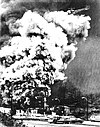| Date | March 25, 1947 |
|---|---|
| Location | Centralia No. 5 coal mine, Washington County section of Wamac, Illinois |
| Casualties | |
| 111 killed | |
| 31 survivors | |
On March 25, 1947, the Centralia No. 5 coal mine exploded near the town of Centralia, Illinois, killing 111 people.[1] The Mine Safety and Health Administration of the United States Department of Labor reported the explosion was caused when an underburdened shot or blown-out shot ignited coal dust. The US Department of Labor lists the disaster as the second worst US mining disaster since 1940 with a total of 111 men dead.[2]
YouTube Encyclopedic
-
1/3Views:232 6795 85136 884
-
The 1947 Centralia Mine Disaster
-
Centralia Coal Mine No 5 Disaster - March 25, 1947 - 3:26PM
-
Centralia Coal Mine No 5 Disaster / Explosion ~ March 25, 1947 ~ Woody Guthrie
Transcription
Mine conditions
The mine had received numerous warnings about conditions prior to the explosion. At that time, 142 men were in the mine; 65 were killed by burns and other injuries and 45 were killed by afterdamp. Eight men were rescued, but one died from the effects of afterdamp. Only 31 miners escaped.[3] United Mine Worker's Union President John L. Lewis testified to Congress that the secretary of the Interior, Jlius Krug, had ignored warnings by inspectors that coal dust had been accumulating, which can cause explosions.[4]
Events
At 3:25 A.M. March 25, 1947 electric power to the mine stopped. Survivors testified that there was a strong blow or rush of dust for about five minutes. One miner claimed that the dust appeared to be a black powder, while a mine employee claimed that he could smell powder smoke, though he did not enter the mine until after the explosion. An Illinois government report claimed that the explosion was caused by buildup of coal powder, though could not find a catalyst. Though the catalyst was likely accidental, the buildup of coal powder was due to the governmental regulaters following a "weak, ineffectual, and indifferent policy toward enforcement of state mining laws".[5]
In popular culture
American folksinger Woody Guthrie wrote and recorded a song about the Centralia mine disaster entitled The Dying Miner.[1] Guthrie's recording of the song is now available on the Smithsonian-Folkways recording Struggle (1990). Songwriter Bucky Halker rearranged this song and recorded it for his Welcome to Labor Land CD (Revolting Records, 2002), a collection of Halker's renditions of labor songs from Illinois. Halker also recorded his version of "New Made Graves of Centralia" for his CD Don't Want Your Millions (Revolting Records, 2000). Halker based his version on an original recording of this song in the Country Music Hall of Fame, but the author and recording artist were unknown.
Along with The Dying Miner, Guthrie wrote two other songs regarding the 1947 disaster: "Waiting at the Gate" (from the perspective of a miner's son); and "Talking Centralia" (also known as "Talking Miner").
References
- ^ a b United States Mine Rescue Association. "Centralia No. 5 Mine Explosion, Centralia, Illinois". Mine Disasters in the United States. Retrieved 2018-06-25.
- ^ Staff. "Historical Data on Mine Disasters in the United States - The six worst coal mine disasters, since 1940". United States Department of Labor/ Mine Safety and Health Administration. Retrieved December 12, 2022.
- ^ O'Neil, Tim (March 25, 2022). "March 25, 1947 • 'Dear wife. Goodbye.' 111 die in southern Illinois mine disaster". St. Louis Post-Dispatch. Retrieved December 12, 2022.
- ^ Hobson, Jeremy (March 25, 2014). "Remembering The Centralia Mine Disaster".
- ^ Pratt, Joseph A. (1987). "Unseen Danger: A Tragedy of People, Government, and the Centralia Mine Fire. By David Dekok. Philadelphia: University of Pennsylvania Press, 1986. xiv + 299 pp. Maps, illustrations, and index. $17.95". Business History Review. 61 (4): 645–646. doi:10.2307/3115362. ISSN 0007-6805.
Further reading
- Death Underground: The Centralia and West Frankfort Mine Disasters. Robert E Hartley, David Kenney. Southern Illinois University Press; 1st ed., (2006) ISBN 0-8093-2706-6
External links
- "Centralia, Illinois, Mine № 5 (in Wamac, Illinois) Disaster of March 25, 1947" in Digital Research Library of Illinois History Journal, article written by Patricia Lofthouse, M.L.S. Edited by Neil Gale, Ph.D.
- Public Sector Safety Professionals: Focused on Activity or Results? Fred Fanning. Spring 2007.
- [1]
38°29′46.572″N 89°8′40.2″W / 38.49627000°N 89.144500°W


